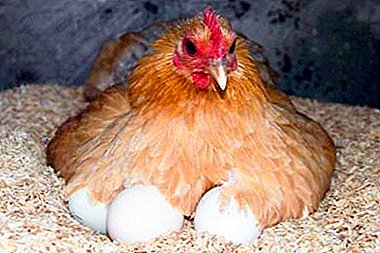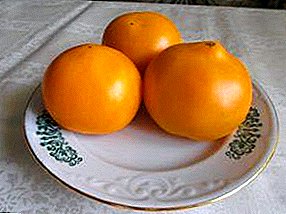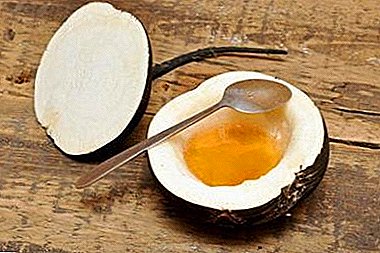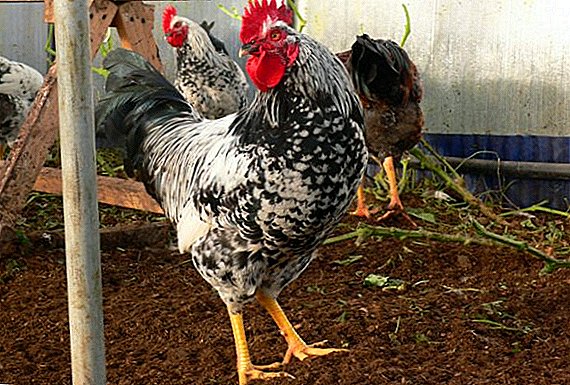
Probably no farm or household can do without chickens, because for humans they are a source of healthy meat and eggs, fluff and feathers. And so that such valuable birds are never translated in the yard, you need to know some rules for their breeding.
In this article we will talk in detail about how to properly raise chickens with chickens, how to choose the right bird and prepare it for brooding, how to choose the right eggs and what kind of care must be provided to the chicken.
How to choose a suitable hen and prepare it for brooding
 Not all chickens become hens. Cross (hybrid) chickens are not chickens, and will never hatch eggs on their own.
Not all chickens become hens. Cross (hybrid) chickens are not chickens, and will never hatch eggs on their own.
Besides, many breeds of chickens just lost their incubation instinct, but our domestic chickens perfectly preserved this instinct. This does not mean that all of them will become hens, out of about twenty chickens, only one will sit on the eggs.
The hen manifests its readiness to become a hen in advance by its behavior. For about a week, she walks, tries on, sits down, avoids a rooster, feathers fall on her belly, with which she warms the nest, and these are sure signs of a potential hen.
She starts laying eggs to her chosen nest, she can even steal them from other chickens, and if she still sat down, then she can no longer be driven away even by a stick. Such a hen is sitting in a nest of laughter, having tightly picked up eggs under itself and spreading its wings, it is pecking painfully if it is disturbed.
reference: Having identified a hen, you should not immediately lay eggs, first you need to test it for 2-3 days on eggs tricks, and if during this time the hen has not thrown the nest, you can safely enclose the hatching ones. This should be done at sunset or even at night.
It happens that a hen arranges a nest in an inappropriate place, in such cases it is necessary to collect its litter and eggs late in the evening and transfer it to the right place. In order for the hen not to run away, it is covered for several days with a box, then it gets used and calms down.
Nest and room preparation
 The nest is placed away from the rest of the birds that can peck future offspring. For the hen chose a quiet dark place to make her feel safe..
The nest is placed away from the rest of the birds that can peck future offspring. For the hen chose a quiet dark place to make her feel safe..
The hen should be spacious there, but at the same time the floor area in the nest should not be large so that the eggs do not roll out. Hay or straw for bedding must be taken dry and clean, crushed eggs should be immediately thrown from the nest.
If the floor is cold, or there are rats, it is advisable to install the nest at a small height or hang it in a box to which you need to lead the ladder. There should be no flies in the room, they can lay eggs in a dug out egg and the hatched larvae will seriously harm the chicken.
You also need to process the chicken coop and the hens themselves from lice peroedy, the hen affected them will not be able to properly hatch eggs. To maintain cleanliness, the room is cleaned daily and ventilated.
The air temperature can vary from 11 to 22 degrees, the bird tolerates cool dry weather very well, but the cold with high humidity can be harmful.
How to lay eggs under the hen correctly
After it became clear that the chicken would sit, it was time to lay the hatching eggs.
They are selected according to the following criteria.:
- eggs must be fresh, free from damage and defects;
- eggs require an odd number, so they are more conveniently distributed under the chicken;
- the number of eggs depends on the size of the chicken, they must be completely hidden under its body and lay in one layer;
- In order for all eggs to be fertilized, the correct ratio of chickens and roosters must be observed; on average, ten chickens require one rooster.
Eggs selected for incubation cannot be kept in nests., you need to take them immediately after the demolition very carefully, with two fingers, so as not to erase the surface layer. You can not wash such eggs. Storage should be dry and cool (12 degrees), they should lie in a horizontal position. It is recommended to turn them over periodically.
During the hatching, it is necessary to make sure that other chickens do not rush into the nest of the hen, or so that it does not roll other people's eggs under itself, since after the first chicks appear, the hen will leave the nest and later eggs will not have time to mature.
What care is required
 In the room in which the hen lives, be sure to put food and fresh water. In the early days, the bird can constantly sit in the nest, it is normal and there is no need to disturb it at this time. The time will come, and she herself will start going out to feed. If the hen stubbornly does not leave the nest, it must be carefully removed and attributed to food.
In the room in which the hen lives, be sure to put food and fresh water. In the early days, the bird can constantly sit in the nest, it is normal and there is no need to disturb it at this time. The time will come, and she herself will start going out to feed. If the hen stubbornly does not leave the nest, it must be carefully removed and attributed to food.
So that the eggs do not overcool during this time, they should be covered with a warm rag. Feeding time should not exceed 20 minutes, but the chicken itself tries to quickly eat and drink, and immediately runs to the clutch.
During its absence in the nest, if necessary, change the litter, throw out the broken shells and eggs, bolts. Regular inspection of the bird feathers for the presence of parasites will help in time to take measures for their destruction. Chickens expel perojedov swimming in the ashes or sand, so the bath with such fillers will be quite useful.
Inspection of eggs to control embryonic development
Already on the fifth day of incubation, it is possible to determine whether there is an embryo in the egg or not. If you look at a bright light, for example, using a powerful flashlight, at the stupid end of the egg with the embryo there is a clearly visible emptiness, inside it is much darker than fresh and even the blood grid on the yolk is visible.
Then there is a little speck - this is the future chicken. The farther, the larger the embryo, and therefore the egg is darker. The main indicator of the presence of the embryo - the contrast of the dark egg and the light air chamber, and usually these eggs are most in laying.
The bolt is visible immediately - it is a muddy egg with a splashing top, if you smell it, you can feel a slightly stale smell. If the embryo develops and then dies, the blood ring appears well in the egg. Such eggs should be thrown out, but if there is even the slightest doubt in the decision, it is better to return the egg to the chicken.
Ideally, for the control of embryonic development, you need to purchase an ovoscope, but it is quite possible to replace it with a lamp or a flashlight. Inspections should be carried out in the absence of a hen, everything should be done quickly and very carefully so as not to chill and break.
How do eggs hatch and hatch
The process of breeding chicks at the hen is very interesting to watch. The nestling develops 21 days and it starts the day before hatching. From the egg, the beak squeaks and knocks on the shell, the chicken reacts anxiously to all this and even talks to the chick.
Then the cracks begin to diverge in the center of the egg, a piece of the lid falls off and a wet chicken appears from the egg. A few hours later, after the feathers dry, it is taken from the nest.
It often happens that the chicken is weak, and cannot independently split the shell, in which case it needs to be helped out.
Important! If the first chicks are not set aside, the hen can throw the remaining eggs, so the hatching should be constantly monitored. The last chickens are no longer taken from the mother, and after all the hatchlings have been bred, the chicks that have been deposited are returned to the nest.
.
How to plant incubator chickens under the chicken
 The incubator is a useful thing, but it cannot replace the mother for the chicks, which will both protect and warm, and teach them how to search for food. All concerns about the incubator chickens fall on the shoulders of the owner, and this is not an easy task. Therefore, if there is a hen hen in the farm, it is advisable to plant chicks against it.
The incubator is a useful thing, but it cannot replace the mother for the chicks, which will both protect and warm, and teach them how to search for food. All concerns about the incubator chickens fall on the shoulders of the owner, and this is not an easy task. Therefore, if there is a hen hen in the farm, it is advisable to plant chicks against it.
In order for the chicken to adopt hatchery chicks, it must be deceived. The chick should be hidden in the palm of your hand so that it does not see it, and gently slip the bird under the wing. So that everything goes well, you need to follow the rules: it should be done on the same day when her chicks hatched, at the latest, on the third day, and you need to sit down in the dark.
This trick works in the event that the chicken has not walked with its brood, so you should not delay with such an important matter.
What to do with the young?
After the chicks have hatched, it is necessary to carry out a primary inspection. Full-fledged chickens are always mobile and respond well to the sounds in the house.
On average, the weight of an individual is 35 g. Young animals should have a soft belly, a clean cesspool of pink tint and a closed umbilical cord. On the body noticeable fluff.
Other signs of a healthy chicken:
- strong legs;
- big head;
- brilliant clean eyes;
- thick short beak;
- pressed to the body wings.
After the chicks have dried, they must be moved along with the hen into the heated house. The room temperature at floor level should be at least 22 degrees. The young growth is very demanding to heat, therefore it needs to be protected from overcooling and drafts.
Chickens are tied to the hen, so the first time the chicken is placed together with the young in the enclosed area with wooden flooring or straw bedding.
 For the young establish their own drinking bowl and feeder. For watering it is better to choose a flat dish or a special drinker in which the chicks will not be able to accidentally drown. The feeding area is separated by a picket fence so that adults do not climb there.
For the young establish their own drinking bowl and feeder. For watering it is better to choose a flat dish or a special drinker in which the chicks will not be able to accidentally drown. The feeding area is separated by a picket fence so that adults do not climb there.
Feed in the first place always give the hen. It is she who makes the sounds that help the youngsters find filled troughs. The first few days you can feed the chickens with breadcrumbs, cottage cheese or boiled eggs. Over time, millet and oatmeal are added to the diet.
When the temperature outside will reach at least 18 C, and the chickens will be 2 weeks old, you can let them go to the yard for walking.
As long as the young are not used to this, they should be able to return to the heated house at any time. This will help them to escape from the cold wind or rain. Without a hen, chicks can be released only 4 weeks after hatching.
Chickens are raised under the hen for 30-40 days., after which the independent life of the young begins. This is explained by the fact that in about a month the chicken can become aggressive and lose its maternal instinct.
In quivering chickens, egg-laying ceases, therefore, it is not worth containing extra hens. In order to deliberately get rid of the incubation instinct, it is worthwhile to place the bird in a box. It is installed on a draft in the courtyard for walking. After 3-5 days, the chicken is returned to the house. After a couple of weeks, she begins to rush.
Growing chickens with a hen has many advantages. Thus, the chicken protects young animals from predators, warms them and helps them navigate the world around them.












